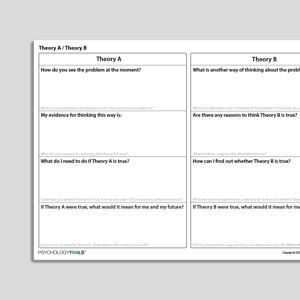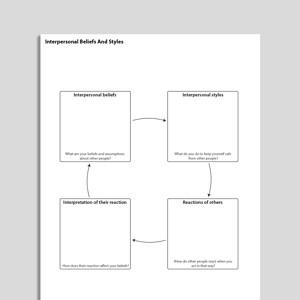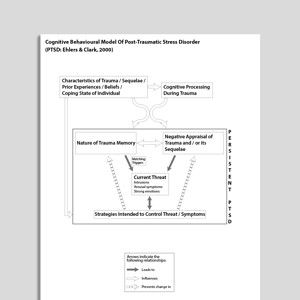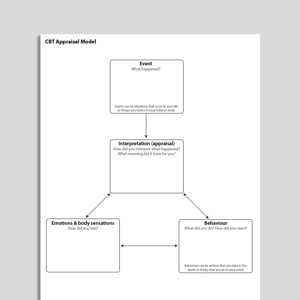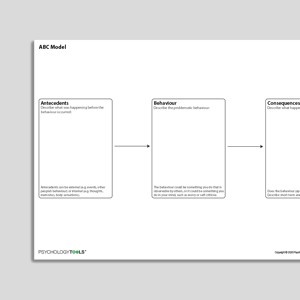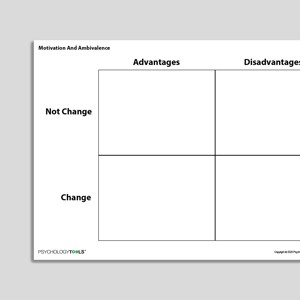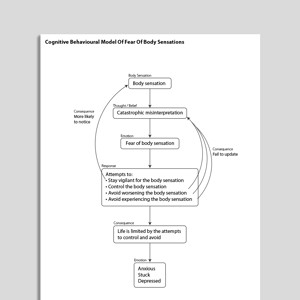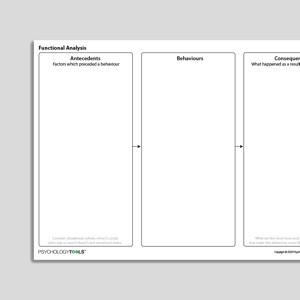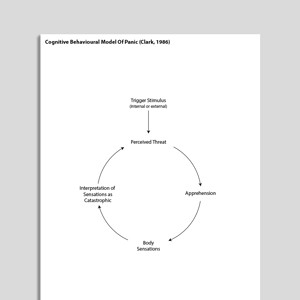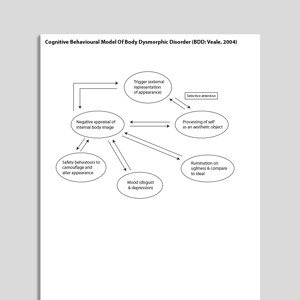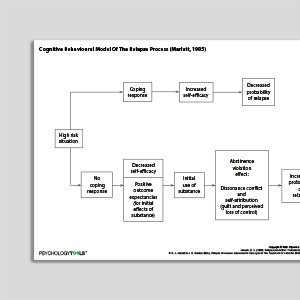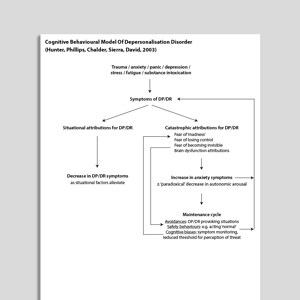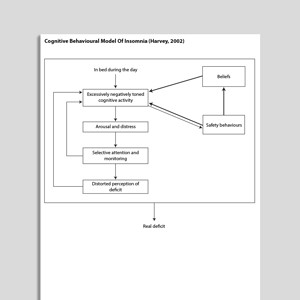Case Formulation and Disorder-Specific Models
“[Formulation is] The lynch pin that holds theory and practice together” (Butler, 1998).Cognitive behavioral therapists use individually tailored formulations as a framework with which to understand their patients’ difficulties and to plan effective treatment. A case formulation helps therapists and patients to understand the origin, current status, and maintenance of a problem. Formulations are developed collaboratively between therapists and patients during the assessment phase of therapy and are revised as new information is gathered during the course of treatment. Jacqueline Persons wrote an influential account of individualized case formulation (1989). Her current case formulation approach (2008) describes how a complete CBT case formulation ties together all of the following parts:
- all of a patient’s symptoms, disorders, and problems;
- hypotheses about the mechanisms causing the disorders and the problems;
- proposes the recent precipitants of the current problems and disorders;
- describes the origins of the mechanisms.

100 of 106 resources
Therapy Blueprint (Universal)
A therapy blueprint is CBT tool which summarizes the work a therapist and patient have completed together. It represents the past (the problems, what ...
https://www.psychologytools.com/resource/therapy-blueprint-universal/
Window Of Tolerance
The window of tolerance concept was coined by Dan Siegel in his 1999 book The Developing Mind. Siegel proposes that everyone has a range of intensitie ...
https://www.psychologytools.com/resource/window-of-tolerance/
Values
Meaningful activity is value-driven. This ACT-informed worksheet explores the key domains of values and encourages clients to reflect upon what is imp ...
https://www.psychologytools.com/resource/values/
Theory A / Theory B
People naturally seek to understand their world and develop explanations based on their experiences. When these beliefs are inaccurate or only partial ...
https://www.psychologytools.com/resource/theorya-theoryb/
Emotions Motivate Actions
Many clients find it helpful to recognize the range of actions that are motivated by different emotional states. This worksheet encourages clients to ...
https://www.psychologytools.com/resource/emotions-motivate-actions/
Cross Sectional Formulation
Case conceptualizations (formulations) help therapists and clients come to a shared understanding of a problem. This Cross Sectional Formulation explo ...
https://www.psychologytools.com/resource/cross-sectional-formulation/
Obsessive Compulsive Disorder (OCD) Formulation
The cognitive approach to obsessive compulsive disorder (OCD) suggesst that it is the client’s interpretation of normal intrusive thoughts, images, ...
https://www.psychologytools.com/resource/obsessive-compulsive-disorder-ocd-formulation/
Motivational Systems (Emotional Regulation Systems)
At the heart of Compassion Focused Therapy (CFT) is an evolutionary model of human motivational systems. Developed by Paul Gilbert it is a helpful len ...
https://www.psychologytools.com/resource/motivational-systems-emotional-regulation-systems/
Low Self-Esteem Formulation
The cognitive approach to low self-esteem proposes that negative beliefs about the self are maintained by biased information processing, including per ...
https://www.psychologytools.com/resource/low-self-esteem-formulation/
Social Anxiety Formulation
People suffering from social anxiety disorder (previously known as social phobia) experience persistent fear or anxiety concerning social or performan ...
https://www.psychologytools.com/resource/social-anxiety-formulation/
Post-Traumatic Stress Disorder (PTSD) Formulation
The cognitive approach to post-traumatic stress disorder (PTSD) suggests that a heightened perception of threat in the here-and-now is maintained by i ...
https://www.psychologytools.com/resource/ptsd-formulation/
Panic Formulation
The cognitive approach to panic suggests that anxiety escalates rapidly when physical sensations of panic are misinterpreted as signs of danger, which ...
https://www.psychologytools.com/resource/panic-formulation/
What Keeps Obsessive Compulsive Disorder (OCD) Going?
The "What Keeps It Going?" series is a set of one-page diagrams explaining how common mental health conditions are maintained. Friendly and concise, t ...
https://www.psychologytools.com/resource/what-keeps-obsessive-compulsive-disorder-ocd-going/
Longitudinal Formulation 2
Case conceptualizations (formulations) help therapists and clients come to a shared understanding of a problem. This longitudinal case formulation wor ...
https://www.psychologytools.com/resource/longitudinal-formulation-2/
Friendly Formulation
Case conceptualizations (formulations) help therapists and clients come to a shared understanding of a problem. This simple CBT formulation worksheet ...
https://www.psychologytools.com/resource/friendly-formulation/
Cognitive Behavioral Model Of Low Self-Esteem (Fennell, 1997)
Low self-esteem is characterized as a negative sense of the self and co-occurs with many other mental health problems. Although not formally represent ...
https://www.psychologytools.com/resource/cognitive-behavioral-model-of-low-self-esteem-fennell-1997/
What Keeps Low Self-Esteem Going?
The “What Keeps It Going?” series is a set of one-page diagrams explaining how common mental health conditions are maintained. Friendly and concis ...
https://www.psychologytools.com/resource/what-keeps-low-self-esteem-going/
What Keeps Social Anxiety Going?
The "What Keeps It Going?" series is a set of one-page diagrams explaining how common mental health conditions are maintained. Friendly and concise, t ...
https://www.psychologytools.com/resource/what-keeps-social-anxiety-going/
Cognitive Behavioral Model Of Health Anxiety (Salkovskis, Warwick, Deale, 2003)
Health anxiety is characterized by a preoccupation with having or acquiring a serious illness, and a high level of anxiety about health. People with h ...
https://www.psychologytools.com/resource/cognitive-behavioral-model-of-health-anxiety-salkovskis-warwick-deale-2003/
Reciprocal CBT Formulation
CBT therapists often describe finding it difficult to apply CBT skills when clients bring relational problems to therapy. Familiar methods of visu ...
https://www.psychologytools.com/resource/reciprocal-cbt-formulation/
What Keeps Panic Going?
The "What Keeps It Going?" series is a set of one-page diagrams explaining how common mental health conditions are maintained. Friendly and concise, t ...
https://www.psychologytools.com/resource/what-keeps-panic-going/
Interpersonal Beliefs And Styles
Interpersonal issues and relationship problems form an important part of what clients bring to therapy: they might present as clients’ current conce ...
https://www.psychologytools.com/resource/interpersonal-beliefs-and-styles/
Stages Of Change
The Stages Of Change model is helpful for conceptualizing the mental states of individuals at different stages of their change journey. This informati ...
https://www.psychologytools.com/resource/stages-of-change/
Cognitive Behavioral Model Of Generalized Anxiety Disorder (GAD: Dugas, Gagnon, Ladouceur, Freeston, 1998)
Individuals with generalized anxiety disorder (GAD) report significant worry which they find difficult to control and experience as distressing. Numer ...
https://www.psychologytools.com/resource/cognitive-behavioral-model-of-generalized-anxiety-disorder-gad-dugas-gagnon-ladouceur-freeston-1998/
Longitudinal Formulation 1
Case conceptualizations (formulations) help therapists and clients come to a shared understanding of a problem. This case formulation worksheet is a t ...
https://www.psychologytools.com/resource/longitudinal-formulation-1/
Cognitive Behavioral Model Of Post Traumatic Stress Disorder (PTSD: Ehlers & Clark, 2000)
Anke Ehlers' & David Clark's Cognitive Behavioral Model Of Post-Traumatic Stress Disorder (PTSD) is an influential account of the condition. The ...
https://www.psychologytools.com/resource/cognitive-behavioral-model-of-post-traumatic-stress-disorder-ptsd-ehlers-clark-2000/
Therapy Blueprint For PTSD
A therapy blueprint represents the past (the problems, what maintained them), the present (the therapy itself, new knowledge learned and skills develo ...
https://www.psychologytools.com/resource/therapy-blueprint-for-ptsd/
Cognitive Behavioral Model Of Intolerance Of Uncertainty And Generalized Anxiety Disorder Symptoms (Hebert, Dugas, 2019)
Intolerance of uncertainty (IU) has been defined as “an underlying fear of the unknown”. Intolerance of uncertainty is a risk factor for the deve ...
https://www.psychologytools.com/resource/cognitive-behavioral-model-of-intolerance-of-uncertainty-and-generalized-anxiety-disorder-symptoms-hebert-dugas-2019/
What Keeps Post-Traumatic Stress Disorder (PTSD) Going?
The "What Keeps It Going?" series is a set of one-page diagrams explaining how common mental health conditions are maintained. Friendly and concise, t ...
https://www.psychologytools.com/resource/what-keeps-post-traumatic-stress-disorder-ptsd-going/
CBT Appraisal Model
The CBT Appraisal Model worksheet is a transdiagnostic formulation tool. The centrality of appraisals underpins all of the disorder-specific cognitive ...
https://www.psychologytools.com/resource/cbt-appraisal-model/
Therapy Blueprint For OCD
A therapy blueprint represents the past (the problems, what maintained them), the present (the therapy itself, new knowledge learned and skills develo ...
https://www.psychologytools.com/resource/therapy-blueprint-for-ocd/
What Keeps Perfectionism Going?
The “What Keeps It Going?” series is a set of one-page diagrams explaining how common mental health conditions are maintained. Friendly and concis ...
https://www.psychologytools.com/resource/what-keeps-perfectionism-going/
CBT Model – Maintaining Processes
Formulation is a key component of cognitive behavioral therapy (CBT) and essential to effective practice. Effective cognitive behavioral formulations ...
https://www.psychologytools.com/resource/cbt-model-maintaining-processes/
Developing Psychological Flexibility
Acceptance and Commitment Therapy (ACT) proposes that suffering is associated with psychological inflexibility. ACT suggests that to increase psycholo ...
https://www.psychologytools.com/resource/developing-psychological-flexibility/
ABC Model
ABC is an acronym for Antecedents, Behavior, Consequences. It is used as a tool for the assessment and formulation of problem behaviors and is useful ...
https://www.psychologytools.com/resource/abc-model/
What Keeps Death Anxiety Going?
The “What Keeps It Going?” series is a set of one-page diagrams explaining how common mental health conditions are maintained. Friendly and concis ...
https://www.psychologytools.com/resource/what-keeps-death-anxiety-going/
How Does Emotion Affect Your Life?
Emotions are an essential part of being human. Everyone experiences a wide variety of emotions in response to changes in their thoughts, biology, and ...
https://www.psychologytools.com/resource/how-does-emotion-affect-your-life/
Recognizing Obsessive Compulsive Disorder (OCD)
Obsessive Compulsive Disorder (OCD) is characterized by the presence of persistent and repeated obsessions and compulsions. The obsessions are intrusi ...
https://www.psychologytools.com/resource/recognizing-obsessive-compulsive-disorder-ocd/
Schema Formulation
Beck's cognitive model proposes that cognition and perception in the here-and-now are influenced by our 'schemas', which shape our perception and info ...
https://www.psychologytools.com/resource/schema-formulation/
Therapy Blueprint
NOTE: An improved version of this resource is available here: Therapy Blueprint (Universal). Older versions of a resource may be archived in the event ...
https://www.psychologytools.com/resource/therapy-blueprint/
CBT Model – Maintaining Processes – Past And Present
Formulation is a key component of cognitive behavioral therapy (CBT) and essential to effective practice. Effective cognitive behavioral formulations ...
https://www.psychologytools.com/resource/cbt-model-maintaining-processes-past-and-present/
Vicious Cycle - Responses And Consequences
Formulation is a key component of talking therapies and vicious cycles have long been recognized in psychotherapy as key mechanisms that perpetuate ps ...
https://www.psychologytools.com/resource/vicious-cycle-responses-and-consequences/
CBT Model – Here And Now
Formulation is a key component of cognitive behavioral therapy (CBT) and essential to effective practice. The CBT Model – Here And Now worksheet is ...
https://www.psychologytools.com/resource/cbt-model-here-and-now/
Motivation and Ambivalence
Motivation is a necessary precursor to change, yet many clients are ambivalent about the process of change. The Motivation And Ambivalence worksheets ...
https://www.psychologytools.com/resource/motivation-and-ambivalence/
Stages Of Social Anxiety
The Stages Of Social Anxiety worksheet is a tool to record unhelpful socially anxious responses to social situations, and to map alternative ways of t ...
https://www.psychologytools.com/resource/stages-of-social-anxiety/
Functional Analysis With Intervention Planning
This classic A-B-C functional analysis worksheet can be used to collect information about what came before a behavior (antecedents), the behavior itse ...
https://www.psychologytools.com/resource/functional-analysis-with-intervention-planning/
Exploring Problems Using A CBT Model
A formulation can take a ‘snapshot’ of what is going on during a single moment in time. The Exploring Problems Using A CBT Model worksheet identif ...
https://www.psychologytools.com/resource/exploring-problems-using-a-cbt-model/
Recognizing Prolonged Grief Disorder
Prolonged Grief Disorder is a disturbance in which there is a persistent and pervasive grief response following the death of loved one. It is characte ...
https://www.psychologytools.com/resource/recognizing-prolonged-grief-disorder/
Therapy Blueprint For Social Anxiety
A therapy blueprint represents the past (the problems, what maintained them), the present (the therapy itself, new knowledge learned and skills develo ...
https://www.psychologytools.com/resource/therapy-blueprint-for-social-anxiety/
Vicious Cycle - Costs And Benefits
Formulation is a key component in talking therapies, and vicious cycles have long been recognized in psychotherapy as key mechanisms that perpetuate p ...
https://www.psychologytools.com/resource/vicious-cycle-costs-and-benefits/
Cognitive Case Formulation
The Cognitive Case Formulation is a CBT case conceptualization tool that aims to help therapists derive core and intermediate beliefs from an analysis ...
https://www.psychologytools.com/resource/cognitive-case-formulation/
What Keeps Fears And Phobias Going?
The “What Keeps It Going?” series is a set of one-page diagrams explaining how common mental health conditions are maintained. Friendly and concis ...
https://www.psychologytools.com/resource/what-keeps-fears-and-phobias-going/
CBT Model – Past And Present
Formulation is a key component of cognitive behavioral therapy (CBT) and essential to effective practice. This CBT Model – Past And Present is a des ...
https://www.psychologytools.com/resource/cbt-model-past-and-present/
Problem List
An important task during the assessment phase of therapy is to identify client difficulties. The Problem List worksheet is a helpful way of gatherin ...
https://www.psychologytools.com/resource/problem-list/
Belief Driven Formulation
Cognitive behavioral theory proposes that our thoughts, feelings, and behavior in the here-and-now are influenced by our schemas / core beliefs / assu ...
https://www.psychologytools.com/resource/belief-driven-formulation/
What Keeps Depersonalization And Derealization Going?
The “What Keeps It Going?” series is a set of one-page diagrams explaining how common mental health conditions are maintained. Friendly and concis ...
https://www.psychologytools.com/resource/what-keeps-depersonalization-and-derealization-going/
Process Focused Case Formulation
The Process-Focused Case Formulation encourages clinicians to make hypotheses regarding mechanisms or processes which they believe may be maintainin ...
https://www.psychologytools.com/resource/process-focused-case-formulation/
Understanding PTSD
Ehlers & Clark's cognitive model of PTSD outline key maintaining factors. Understanding PTSD is a simple pictorial explanation of the maintenance ...
https://www.psychologytools.com/resource/understanding-ptsd/
Cognitive Behavioral Model Of Social Phobia (Clark, Wells, 1995)
People suffering from social anxiety disorder (previously known as social phobia) experience persistent fear or anxiety concerning social or performan ...
https://www.psychologytools.com/resource/cognitive-behavioral-model-of-social-phobia-clark-wells-1995/
Cognitive Behavioral Model of Perfectionism (Shafran, Egan, Wade, 2010)
People with perfectionism pursue high standards in one or more areas of their life, and base their self-worth on their ability to achieve these standa ...
https://www.psychologytools.com/resource/cognitive-behavioral-model-of-perfectionism-shafran-egan-wade-2010/
Cognitive Behavioral Model Of Fear Of Body Sensations
Fear of bodily sensations is present in a number of conditions, most notably panic disorder. The Cognitive Behavioral Model Of Fear Of Bodily Sensatio ...
https://www.psychologytools.com/resource/cognitive-behavioral-model-of-fear-of-body-sensations/
Recognizing Complex Post Traumatic Stress Disorder
Complex Post Traumatic Stress Disorder (Complex PTSD) may develop after exposure to an event (or series of events) of an extremely threatening or horr ...
https://www.psychologytools.com/resource/recognizing-complex-post-traumatic-stress-disorder/
What Keeps Body Dysmorphic Disorder (BDD) Going?
The “What Keeps It Going?” series is a set of one-page diagrams explaining how common mental health conditions are maintained. Friendly and concis ...
https://www.psychologytools.com/resource/what-keeps-body-dysmorphic-disorder-bdd-going/
Treatment Planning Checklist
Some clients find it difficult to generate treatment goals for therapy. This simple handout presents problems that some people bring to therapy. It ca ...
https://www.psychologytools.com/resource/treatment-planning-checklist/
Exploring Problems Using An A-B-C Model
An Antecedent-Behavior-Consequence (ABC) diagram is a form of functional analysis and is a helpful way of conceptualizing a behavior of interest. It e ...
https://www.psychologytools.com/resource/exploring-problems-using-an-a-b-c-model/
Therapy Blueprint For Panic
A therapy blueprint represents the past (the problems, what maintained them), the present (the therapy itself, new knowledge learned and skills develo ...
https://www.psychologytools.com/resource/therapy-blueprint-for-panic/
Daily Monitoring Form
Activity diaries can be used for activity monitoring during an assessment phase of therapy, symptom monitoring during therapy, correlating activity wi ...
https://www.psychologytools.com/resource/daily-monitoring-form/
Functional Analysis
Functional analysis examines the causes and consequences of behavior. This classic A-B-C Functional Analysis worksheet can be used to collect informat ...
https://www.psychologytools.com/resource/functional-analysis/
Cognitive Behavioral Model Of Panic (Clark, 1986)
The Cognitive Behavioral Model Of Panic identifies catastrophic misinterpretation of body sensations as a criticial maintenance factor which serves to ...
https://www.psychologytools.com/resource/cognitive-behavioral-model-of-panic-clark-1986/
Cognitive Behavioral Model Of Body Dysmorphic Disorder (BDD: Veale, 2004)
Individuals with body dysmorphic disorder (BDD) experience distress associated with their body image. The Cognitive Behavioral Model Of Body Dysmorphi ...
https://www.psychologytools.com/resource/cognitive-behavioral-model-of-body-dysmorphic-disorder-bdd-veale-2004/
Transdiagnostic Processes
A ‘transdiagnostic process’ is the label given to a mechanism which is present across disorders and which is either a risk or maintaining factor f ...
https://www.psychologytools.com/resource/transdiagnostic-processes/
Recognizing Generalized Anxiety Disorder (GAD)
Generalized anxiety disorder (GAD) is characterized by marked symptoms of anxiety that persist, more days than not, for at least several months. Peopl ...
https://www.psychologytools.com/resource/recognizing-generalized-anxiety-disorder-gad/
Emotion Focused Formulation
The Emotion Focused Formulation was developed by Isabel Clarke in an acute mental health context but this approach also has wider applicability. It pl ...
https://www.psychologytools.com/resource/emotion-focused-formulation/
Recognizing Post Traumatic Stress Disorder (PTSD)
Post Traumatic Stress Disorder (PTSD) may develop after exposure to an extremely threatening or horrific event, or series of events. It is characteriz ...
https://www.psychologytools.com/resource/recognizing-post-traumatic-stress-disorder-ptsd/
Cognitive Behavioral Model Of The Relapse Process (Marlatt & Gordon, 1985)
Marlatt & Gordon’s cognitive behavioral model of relapse (1985) conceptualizes relapse as a “transitional process, a series of events that unf ...
https://www.psychologytools.com/resource/cognitive-behavioural-model-of-the-relapse-process-marlatt-gordon-1985/
Recognizing Depersonalization-Derealization Disorder (DPD)
Depersonalization-Derealization Disorder is characterized by experiences of unreality and detachment from oneself and the world. Experiences of depers ...
https://www.psychologytools.com/resource/recognizing-depersonalization-derealization-disorder-dpd/
Transdiagnostic Cognitive Behavioral Model Of Eating Disorders (Fairburn, Cooper, Shafran, 2003)
Fairburn, Cooper & Shafran (2003) argue that eating disorders such as anorexia and bulimia share common maintenance mechanisms despite difference ...
https://www.psychologytools.com/resource/transdiagnostic-cognitive-behavioral-model-of-eating-disorders-fairburn-cooper-shafran-2003/
Cognitive Behavioral Model Of Depersonalization (Hunter, Phillips, Chalder, Sierra, David, 2003)
Depersonalization is an experience where an individual feels a sense of detachment from themselves, or estrangement from their perceptions, actions, a ...
https://www.psychologytools.com/resource/cognitive-behavioral-model-of-depersonalization-hunter-phillips-chalder-sierra-david-2003/
Cognitive Behavioral Model Of Clinical Perfectionism (Shafran, Cooper, Fairburn, 2002)
People with perfectionism pursue high standards in one or more areas of their life and base their self-worth on their ability to achieve these standar ...
https://www.psychologytools.com/resource/cognitive-behavioral-model-of-clinical-perfectionism-shafran-cooper-fairburn-2002/
Making Sense Of Your Panic (Psychology Tools For Overcoming Panic)
Psychology Tools for Overcoming Panic takes a cognitive behavioral therapy (CBT) approach to this common anxiety problem. This chapter brings tog ...
https://www.psychologytools.com/resource/making-sense-of-your-panic-psychology-tools-for-overcoming-panic/
What Keeps Anorexia Going?
The “What Keeps It Going?” series is a set of one-page diagrams explaining how common mental health conditions are maintained. Friendly and concis ...
https://www.psychologytools.com/resource/what-keeps-anorexia-going/
Recognizing Social Anxiety Disorder
Social Anxiety Disorder is characterized by excessive fear regarding one or more social situations. People with social anxiety are concerned about bei ...
https://www.psychologytools.com/resource/recognizing-social-anxiety-disorder/
Recognizing Binge Eating Disorder
Binge Eating Disorder is characterized by frequent and recurrent episodes of binge eating, which is defined as a period of time in which the individua ...
https://www.psychologytools.com/resource/recognizing-binge-eating-disorder/
What Keeps Bulimia Going?
The “What Keeps It Going?” series is a set of one-page diagrams explaining how common mental health conditions are maintained. Friendly and concis ...
https://www.psychologytools.com/resource/what-keeps-bulimia-going/
Recognizing Agoraphobia
Agoraphobia is characterized by marked and excessive fear of situations such as open or public spaces where escape or help might not be available, and ...
https://www.psychologytools.com/resource/recognizing-agoraphobia/
Classical Conditioning
Classical conditioning is a process by which stimuli become associated with responses. This information handout describes key principles of Classical ...
https://www.psychologytools.com/resource/classical-conditioning/
Cognitive Behavioral Model Of Insomnia (Harvey, 2002)
Insomnia is a highly prevalent sleep disorder characterized by difficulty initiating or maintaining sleep, or having non-restorative sleep for at leas ...
https://www.psychologytools.com/resource/cognitive-behavioral-model-of-insomnia-harvey-2002/
Alternative Action Formulation
The Alternative Action Formulation is a CBT case conceptualization (formulation) worksheet. Formulations help a client and therapist come to a shared ...
https://www.psychologytools.com/resource/alternative-action-formulation/
Recognizing Panic Disorder
Panic attacks are discrete episodes of intense fear or apprehension which are accompanied by the rapid onset of characteristic physiological and cogni ...
https://www.psychologytools.com/resource/recognizing-panic-attacks-and-panic-disorder/
Operant Conditioning
Operant conditioning / instrumental learning is a mechanism by which behaviors can be strengthened or weakened over time. This information handout des ...
https://www.psychologytools.com/resource/operant-conditioning/
Recognizing Specific Phobia
Specific phobia is characterized by marked and excessive fear or anxiety concerning a particular object or situation, and which is out of proportion t ...
https://www.psychologytools.com/resource/recognizing-specific-phobia/
What Keeps Tinnitus Going
What Keeps Tinnitus Going is a tinnitus formulation diagram which combines information about neurological-level change (the brain’s ‘filter’) an ...
https://www.psychologytools.com/resource/what-keeps-tinnitus-going/
Recognizing Body Dysmorphic Disorder
Body Dysmorphic Disorder is characterized by the persistent preoccupation with defects or flaws in one’s appearance that are either unnoticeable or ...
https://www.psychologytools.com/resource/recognizing-body-dysmorphic-disorder/
Cognitive Behavioral Model Of Bulimia Nervosa (Fairburn, Cooper, Shafran, 2003)
Bulimia nervosa is an eating disorder characterized by binge eating followed by purging. Among young women, the point prevalence of bulimia is about 1 ...
https://www.psychologytools.com/resource/cognitive-behavioral-model-of-bulimia-nervosa-fairburn-cooper-shafran-2003/
Cognitive Behavioral Model Of Anorexia Nervosa (Fairburn, Cooper, Shafran, 2003)
Anorexia nervosa is an eating disorder characterized by restriction of energy intake and intense fear of gaining weight. For women, the lifetime preva ...
https://www.psychologytools.com/resource/cognitive-behavioral-model-of-anorexia-nervosa-fairburn-cooper-shafran-2003/
Cognitive Behavioral Model Of Tinnitus (McKenna, Handscombe, Hoare, Hall, 2014)
The Cognitive Behavioral Model Of Tinnitus identifies cognitive, behavioral, and perceptual changes which operate to maintain tinnitus perception and ...
https://www.psychologytools.com/resource/cognitive-behavioral-model-of-tinnitus-mckenna-handscombe-hoare-hall-2014/
SWOT Analysis
SWOT Analysis is a tool, originally from management theory, which can help to guide action in the face of uncertainty or ambivalence. Clients can be a ...
https://www.psychologytools.com/resource/swot-analysis/
Cognitive Behavioral Model Of Persistent Postural-Perceptual Dizziness (PPPD: Whalley, Cane, 2017)
Persistent postural-perceptual dizziness (PPPD) is a form of dizziness which is thought to be maintained by psychological factors. This is a Cognitive ...
https://www.psychologytools.com/resource/cognitive-behavioral-model-of-persistent-postural-perceptual-dizziness-pppd-whalley-cane-2017/
Recognizing Hoarding Disorder
Hoarding Disorder is characterized by the ongoing accumulation of possessions that result in living spaces becoming overwhelmed to the point that thei ...
https://www.psychologytools.com/resource/recognizing-hoarding-disorder/
How Does This All Add Up To A Panic Attack? (Psychology Tools For Overcoming Panic)
Psychology Tools for Overcoming Panic takes a cognitive behavioral therapy (CBT) approach to this common anxiety problem. This chapter discusses the ...
https://www.psychologytools.com/resource/how-does-this-all-add-up-to-a-panic-attack-psychology-tools-for-overcoming-panic/
Links to external resources
Psychology Tools makes every effort to check external links and review their content. However, we are not responsible for the quality or content of external links and cannot guarantee that these links will work all of the time.
Assessment
-
Collaborative Case Conceptualization Rating Scale (CCC-RS)
| Kuyken, Padesky, Dudley | 2009
- Kuyken, W., Beshai, S., Dudley, R., Abel, A., Görg, N., Gower, P., … & Padesky, C. A. (2016). Assessing competence in collaborative case conceptualization: Development and preliminary psychometric properties of the Collaborative Case Conceptualization Rating Scale (CCC-RS).Behavioural and Cognitive Psychotherapy,44(2), 179-192.
- Rating scale & coding manual
- Score sheet & feedback form
Case Conceptualization / Case Formulation
- Formulation in Compassion Focused Therapy | Paul Gilbert | 2007
- Maxi formulation | Helen Moya
-
EMDR Case Formulation Tool
| Ines Santos | 2019
- Journal Article
- V1 – PDF
- V2 - PDF
- V2 - Word
- The “Blobby” formulation | Helen Kennerley | 2015
- Good practice guidelines on the use of psychological formulation | British Psychological Society: Division Of Clinical Psychology
- A quick guide to ACT case conceptualization | Russ Harris | 2009
- Outline of ACT assessment / case formulation process | Jason Luoma
- ACT simple case formulation | Julian McNally
- Team formulation: key considerations in mental health services | Association of Clinical Psychologists UK | 2022
- DBT Case Formulation Format | Comtois
- The case formulation approach to cognitive behavior therapy | Jacqueline Persons | 2014
- A case formulation approach to cognitive-behavior therapy | Jacqueline Persons | 2015
Information Handouts
- Cycle vs. Heart Illustration for EFT | Paul Sigafus | 2013
Information (Professional)
- Working with Schemas, Core Beliefs, and Assumptions | Frank Wills | 2008
Presentations
- EMDR: Using Case Formulation In Treatment Planning And Target Selection | Ines Santos | 2023
- Cafe formulation in cognitive-behavioral therapy | Caleb Lack
- The role of a case conceptualization model and core tasks of intervention | Donald Miechenbaum | 2014
Video
- CBT case formulation | Jacqueline Persons
- The Newcastle Model – A family guide for inpatient units | CNTW NHS Trust | BPS DCP FPOP | 2020
- Formulations used in the UK for the management of behaviours that challenge | Ian James | 2022
- Formulations In Dementia Care | CNTW NHS Trust | BPS DCP FPOP | 2020
Worksheets
- Case Formulation Template
Recommended Reading
Cognitive Behavioral Models Of Disorders
- Vlaeyen, J. W. S., & Linton, S. J. (2000). Fear-avoidance and its consequences in chronic musculoskeletal pain: a state of the art. Pain, 85(3), 317–332.
- Espie, C. A. (2002). Insomnia: conceptual issues in the development, persistence, and treatment of sleep disorder in adults. Annual Review of Psychology, 53, 215–243.
- Fairburn, C. G., Cooper, Z., & Shafran, R. (2003). Cognitive behaviour therapy for eating disorders: A “transdiagnostic” theory and treatment.Behaviour Research and Therapy,41(5), 509-528.
- Fennell, M. J. (1997). Low self-esteem: A cognitive perspective. Behavioral and Cognitive Psychotherapy, 25(1), 1-26.
- Fernie, B. A., Bharucha, Z., Nikčević, A. V., Marino, C., & Spada, M. M. (2017). A Metacognitive model of procrastination. Journal of Affective Disorders, 210, 196-203.
- Garety, P. A., Kuipers, E., Fowler, D., Freeman, D., & Bebbington, P. E. (2001). A cognitive model of the positive symptoms of psychosis. Psychological Medicine, 31(2), 189-195.
- Harvey, A. G. (2002). A cognitive model of insomnia. Behavior Research and Therapy, 40, 869–894.
- Heimberg, R. G., & Becker, R. E. (1981). Cognitive and behavioral models of assertive behavior: Review, analysis and integration. Clinical Psychology Review, 1(3), 353-373.
- Mansueto, C. S., Golomb, R. G., Thomas, A. M., & Stemberger, R. M. T. (1999). A comprehensive model for behavioral treatment of trichotillomania. Cognitive and Behavioral Practice, 6(1), 23-43.
- Marlatt, G. A. (1985). Relapse prevention: Theoretical rationale and overview of the model. In G. A. Marlatt & J. R. Gordon (Eds.), Relapse prevention (1st ed., pp. 280–250). New York: Guilford Press.
- Morrison, A. P. (2001). The interpretation of intrusions in psychosis: an integrative cognitive approach to hallucinations and delusions. Behavioural and Cognitive Psychotherapy, 29(3), 257-276.
Social Anxiety Disorder
- Moscovitch, D. A. (2009). What is the core fear in social phobia? A new model to facilitate individualized case conceptualization and treatment. Cognitive and Behavioural Practice, 16. 123-134
Cognitive Behavioral Models Of Disorders
- Salkovskis, P. M., Forrester, E., & Richards, C. (1998). Cognitive–behavioral approach to understanding obsessional thinking.The British Journal of Psychiatry,173(S35), 53-63.
- Salkovskis, P. M., Warwick, H. M. C., Deale, A. C. (2003). Cognitive-Behavioral Treatment for Severe and Persistent Health Anxiety (Hypochondriasis).Brief Treatment and Crisis Intervention, 3, 353-367
- Ehlers, A., & Clark, D. M. (2000). A cognitive model of posttraumatic stress disorder. Behaviour Research and Therapy, 38(4), 319-345.
Generalized Anxiety Disorder
- Wells, A. (1995). Meta-cognition and worry: A cognitive model of generalized anxiety disorder.Behavioural and cognitive psychotherapy,23(3), 301-320
Cognitive Behavioral Models Of Disorders
- Whalley, M. G., & Cane, D. A. (2017). A cognitive-behavioral model of persistent postural-perceptual dizziness. Cognitive and Behavioral Practice, 24(1), 72-89.
Team formulation
- Berry, K., Haddock, G., Kellett, S., Roberts, C., Drake, R., & Barrowclough, C. (2016). Feasibility of a ward‐based psychological intervention to improve staff and patient relationships in psychiatric rehabilitation settings. British Journal of Clinical Psychology, 55(3), 236-252.
- What is the case formulation approach to cognitive-behavior therapy? | Jacqueline Persons | 2008
Case formulation / Case conceptualization
- Geisser, S., & Rizvi, S. L. (2014). The Case of” Sonia” Through the Lens of Dialectical Behavior Therapy.Pragmatic Case Studies in Psychotherapy,10(1), 30-39.
- Haynes, S. N., Leisen, M. B., Blaine, D. D. (1997). Design of individualized behavioral treatment programs using functional analytic clinical case models. Psychological Assessment, 9(4), 334-348
- Kuyken, W., Padesky, C. A., Dudley, R. (2008). The science and practice of case conceptualization. Behavioural and Cognitive Psychotherapy, 36, 757-768
- Persons, J. B., & Lisa, S. T. (2015). Developing and Using a Case Formulation to Guide Cognitive-Behavior Therapy. Journal of Psychology & Psychotherapy, 5(2), 1
- Special issue: Team formulation. (2015). Clinical Psychology Forum, 275.
- Spencer, H. M., Dudley, R., Johnston, L., Freeston, M. H., Turkington, D., & Tully, S. (2022). Case formulation—A vehicle for change? Exploring the impact of cognitive behavioural therapy formulation in first episode psychosis: A reflexive thematic analysis. Psychology and Psychotherapy: Theory, Research and Practice.
Cognitive Behavioral Models Of Disorders
- Boelen, P. A., van den Hout, M. A., & van den Bout, J. (2006). A Cognitive-Behavioral Conceptualization of Complicated Grief. Clinical Psychology: Science and Practice, 13(2), 109–128.
Generalized Anxiety Disorder
- Borkovec, T. D., Alcaine, O., & Behar, E. (2004). Avoidance theory of worry and generalized anxiety disorder.Generalized anxiety disorder: Advances in research and practice,2004.
Cognitive Behavioral Models Of Disorders
- Chapman, A. L., Gratz, K. L., & Brown, M. Z. (2006).Solving the puzzle of deliberate self-harm: The experiential avoidance model.Behaviour Research and Therapy, 44(3), 371–394.
- Clark, D. M. (1986). A cognitive approach to panic. Behaviour Research and Therapy, 24(4), 461-470.
- Clark, D. M., & Wells, A. (1995). A cognitive model of social phobia.Social phobia: Diagnosis, assessment, and treatment,41(68), 00022-3.
Generalized Anxiety Disorder
- Dugas, M. J., Gagnon, F., Ladouceur, R., & Freeston, M. H. (1998). Generalized anxiety disorder: A preliminary test of a conceptual model.Behaviour research and therapy,36(2), 215-226.
What Is Case Conceptualization / Case Formulation?
Types of Case Formulation
Case formulations can vary according to their purpose, and according to the information they attempt to convey. A number of types of formulation have been described:
- A cross-sectional formulation presents information relevant to a short time period, as though an event were sliced open at a particular moment in time to reveal the triggering event, thoughts (interpretations/appraisals), emotions, body feelings, and behaviors or reactions. One of the most popular formats for a cross-sectional formulation is Padesky and Mooney’s ‘hot cross bun’ (1990).
- A longitudinal formulation presents information relevant to the origin and maintenance of a problem. Weerasekera’s “Multiperspective model” popularized the use of the “5 Ps” approach (presenting, predisposing, precipitating, perpetuating, and protective) to case formulation (Weerasekera, 1993). Judith Beck’s cognitive conceptualization (1995) links longitudinal factors (including relevant childhood data, core beliefs, conditional assumptions, coping strategies) to cross-sectional breakdowns (situation, automatic thought and appraisal, emotion, behavior).
- Micro-formulations have been described as a helpful way of understanding the origin and effects of troubling imagery (Hackmann, Bennett-Levy, & Holmes, 2011). In this approach problematic images are explored along with their origin, associated appraisals, current impact, maintenance factors, and cognitive consequences.
- Disorder-specific models describe the critical presenting, predisposing, precipitating, and perpetuating factors relevant to a condition. Disorder-specific cognitive behavioral conceptualizations have been published for most conditions including low self-esteem, panic, obsessive-compulsive disorder, psychosis, post-traumatic stress disorder.
References
- Beck, J. S. (1995). Cognitive behavior therapy: Basics and beyond. New York: Guilford Press.
- Butler, G. (1998). Clinical formulation. In A. S. Bellack and M. Hersen (eds) Comprehensive clinical psychology. New York: Pergamon Press
- Hackmann, A., Bennett-Levy, J., & Holmes, E. A. (2011). Oxford guide to imagery in cognitive therapy. New York: Oxford University Press.
- Padesky, C. A., & Mooney, K. A. (1990). Presenting the cognitive model to clients. International Cognitive Therapy Newsletter, 6, 13–14.
- Persons, J. B. (1989). Cognitive therapy in practice: A case formulation approach. New York: WW Norton.
- Persons, J. (2008). The case formulation approach to cognitive-behavior therapy (guides to individualized evidence-based treatment).
- Weerasekera, P. (1993). Formulation: A multiperspective model. Canadian Journal of Psychiatry, 38(5), 351–358.



